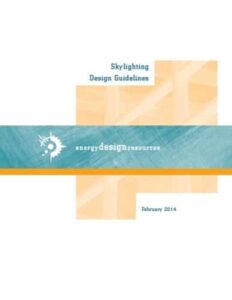The Skylighting design Guidelines 2nd Edition
The Skylighting design Guidelines 2nd Edition
The Skylighting design Guidelines 2nd Edition were prepared to help designers optimize the use of skylights in commercial and industrial buildings. They describe opportunities for energy savings and high quality lighting design offered by skylights. They explain how to integrate skylights with the design of other building elements. They show how to estimate the potential energy savings and cost savings. Finally, they help designers avoid mistakes that could reduce the value of a skylight design.
Many of the lighting Skylighting Design Guidelines _coverprinciples covered here are also applicable to residential buildings. They describe opportunities for high quality lighting design and explain how to integrate skylights with the design of other building elements. They show how to estimate the potential energy savings and cost savings. Finally, they help designers avoid mistakes that could reduce the value of a skylight design.
You can also Read Domestic Central Heating Wiring Systems and Controls
The use of skylights continues to grow, both because they enliven building interiors and because they can save energy and money through daylighting. Skylighting (skylights plus daylight controls) can be a solid asset for almost any building, and help to satisfy human needs for building owners and occupants.
When properly designed, skylights can make a number of major contributions to the built environment:
- Skylights provide high quality lighting conditions to building interiors
![The Skylighting design Guidelines]()
- Skylights reduce the use of electric lighting, to save energy and reduce peak electric loads, when combined with effective photosensor control systems
- The Skylights provide visual and thermal comfort for building occupants
- Skylights increase safety and security with highly reliable daytime lighting
- Skylights provide emergency smoke vents
These Guidelines apply primarily to skylight applications designed to provide uniform lighting for commercial or industrial buildings. They refer to manufactured, off-the-shelf skylight components used in commercial applications, commonly referred to as “unit skylights.” These typically simple, rectangular or linear skylights, although with creativity they can be applied to nearly any design situation. These Guidelines will also briefly discuss more specialized products such as Light Redirecting Skylights and Tubular Daylighting Devices (TDDs).


Comments are closed.